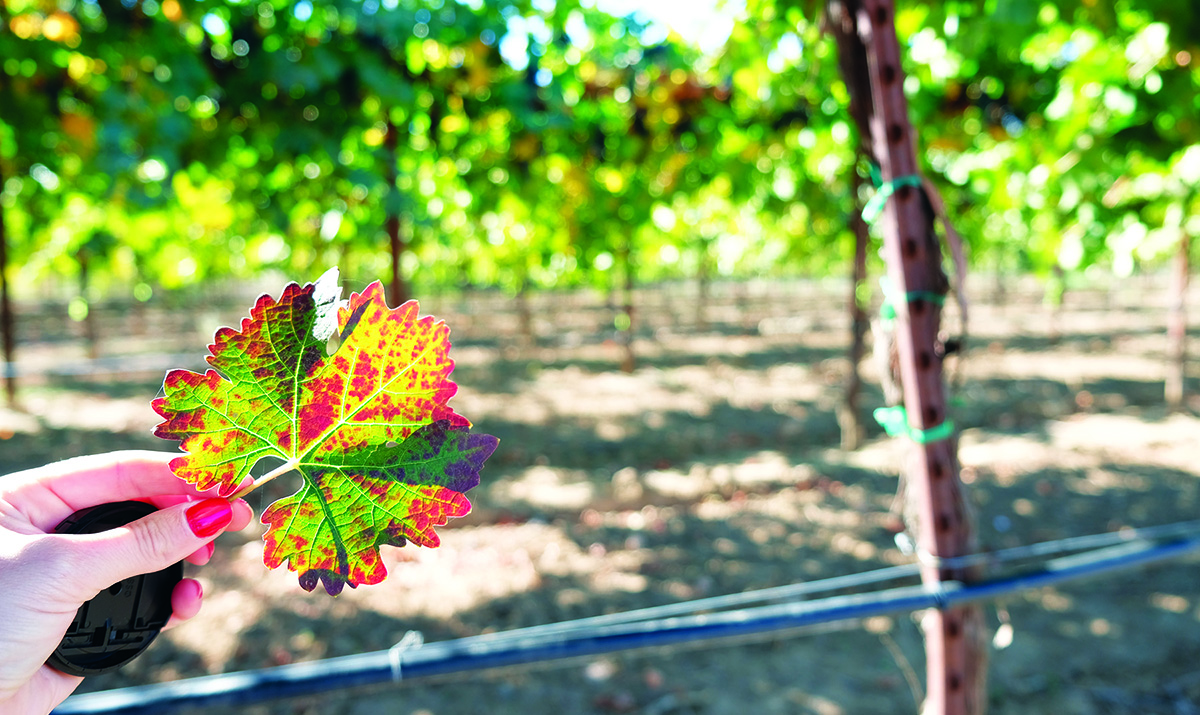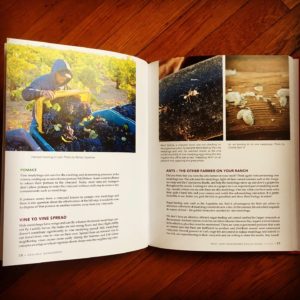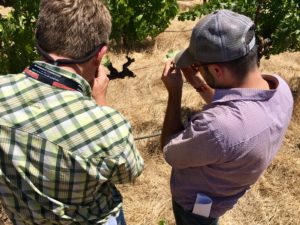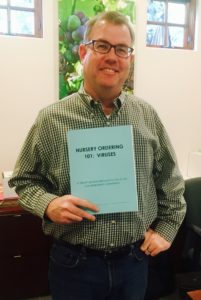
Grapevine Virus Resources
The Lodi Winegrape Commission has been actively studying the California grapevine virus situation since 2017. The Commission’s Research, Education, & Communications Committee has formed two teams which have been instrumental in gathering information, creating educational materials, and offering real-world, practical outreach for our winegrowing community: the Lodi Mealybug Biocontrol Research Focus Group and the Lodi Grapevine Virus Research Focus Group.
Grapevine viruses pose a severe threat to the sustainability of California viticulture. Unfortunately, there is little faith in virus prevention at any level. Growers are losing contract dollars as wineries reject grape loads due to virus-induced ripening problems. The good news is that there are virus management strategies that growers can implement right now in the short-term, which can be taught through real-world, hands-on integrated outreach from a team of growers, extension personnel, PCAs, and scientists. With the right communication, a long-term cooperative virus strategy can save the California industry from devastating future losses.
Both the Mealybug Biocontrol and the Grapevine Virus Research Focus Groups were funded via grants from the American Vineyard Foundation, and the Virus Focus Group is aided by additional funds from the CDFA PD/GWSS Board for a project titled “Grapevine Virus Management in Lodi: A Collaborative Research & Integrated Outreach Effort to Help Solve a Statewide Challenge.“
 NEW GROWER VIRUS WORKBOOKS AVAILABLE
NEW GROWER VIRUS WORKBOOKS AVAILABLE
Thanks to American Vineyard Foundation, CDFA PD/GWSS Board, and Lodi Winegrape Commission funding, members of the Lodi Grapevine Virus Research Focus Group and experts produced a 138-page book for the winegrowing community called WHAT EVERY WINEGROWER SHOULD KNOW: VIRUSES. Full of pictures and written in grower language, the book addresses these topics and more: grapevine virus basics, nursery ordering, mealybugs, beneficial insects, virus testing, mapping your vineyard, virus spread, infected vine removal (including the USDA TAP), local case studies, and the sudden vine collapse. Hard copy and electronic versions (with educational videos) are available. Email Dr. Stephanie Bolton (stephanie@lodiwine.com) to get your copy. Books will continue to be available while copies last.
To sign up for our new grapevine virus email list-serve, where you’ll be invited to all outreach events and given any important updates as they come along, send an email to Dr. Stephanie Bolton with the subject “virus email list subscribe.”
The Commission is happy to announce that Lodi is part of a CDFA BIFS project team looking at “Refinement and Implementation of an Areawide Program for Vineyard Pathogens and their Insect Vectors” and led by Dr. Kent Daane. This project continues decades of work studying the regional management of mealybugs and leafroll virus in Lodi and the Central Coast.
OUTREACH VIDEOS
Below are recordings from the Lodi Mealybug & Virus Outreach Meeting on April 4th, 2019. Speakers included Dr. Kent Daane (UCCE, vine mealybug expert), Dr. Marc Fuchs (Cornell Univ., grapevine virus expert), Prof. Gerhard Pietersen (South Africa, leafroll virus expert), and Dr. James Stamp (Stamp Associates, planting material expert). There is a Q&A panel with the speakers, Chris Storm (Vino Farms, viticulturist) and Aaron Lange (LangeTwins, Vineyard Operations). Funding for this meeting was provided by the American Vineyard Foundation, the CDFA PD/GWSS Board, the Lodi Winegrape Commission, and UCCE. Over 250 people were in attendance and there are a lot of great take-home messages for virus management.
LEAFROLL VIRUS SPREAD VIDEO:
WESTERN SARE MEALYBUG BIOCONTROL VIDEO:
MALE MEALYBUG LOVES PHEROMONE LURE MORE THAN FEMALE MEALYBUG, VIDEO COURTESY OF DR. NATHAN MERCER (UC):
SUDDEN VINE COLLAPSE
As you are likely aware, we’ve been studying a mysterious vine collapse situation (happening mostly in San Joaquin, Stanislaus, and Coastal Counties in California thus far) since around 2010. Patches of grapevines collapse over time – some of the growers saw 30% of a vineyard block collapse within just two years. The vines may show stunted shoots and they usually push out some fruit before collapsing. We have seen this collapse happen mostly on Freedom rootstock, but we now have confirmed cases on O39-16 and 101-14 and there are likely other rootstocks affected as well. Many tests were conducted over the years by several PCAs and researchers until in 2018 a local team started uniformly collecting case studies and testing the patches in a consistent manner. During the summer of 2019, Dr. Akif Eskalen and Dr. Maher Al Rwahnih came to Lodi to collect samples from four affected sites for high-throughput sequencing (HTS) to test for known viruses and any possible novel virus/es, and a thorough fungal analysis (partially funded by the Lodi Winegrape Commission). Every collapsing vine tested positive for a leafroll virus and for a vitivirus. There were trunk disease pathogens isolated from each sample, but not the same ones. We continue to collect case studies to investigate the potential role of leafroll virus and vitiviruses in the collapse disease complex. At this point, it is looking like a combination of a leafroll virus-sensitive rootstock, a leafroll virus, a vitivirus, and another stress (which could be possibly trunk pathogens, crop or water stress, etc.), leads to the collapse – which may be a form of virus-induced rootstock incompatibility. Learn more at any CD11 LODI IPM NETWORK BREAKFAST meeting (held on the first Tuesday of every month, 8am, Burgundy Hall, Lodi Grape Festival Grounds – paused due to pandemic) or the next MEALYBUG & VIRUS OUTREACH MEETING. All are welcome. There is a significant amount of information about the Sudden Vine Collapse – including how to test for it and tips on management – included in the new virus workbook, WHAT EVERY WINEGROWER SHOULD KNOW: VIRUSES (available now by contacting stephanie@lodiwine.com).
Articles about the Sudden Vine Collapse:
- Read our Lodi Growers Coffee Shop Blog article posted on February 24, 2020. “Sudden Vine Collapse.” By Stephanie Bolton, PhD. Reviewed by Maher Al Rwahnih, PhD, Akif Eskalen, PhD, and Charlie Starr IV, PCA.
- Read Ted Rieger’s re-cap of the October 1, 2019 Mystery Vine Collapse Update Meeting in Lodi, hosted by the Lodi Winegrape Commission: “Sudden Vine Collapse May Be Associated with Combination of Virus Pathogens” (Wine Business Monthly).
- Read the Chapter on the Sudden Vine Collapse in the grower virus workbook, WHAT EVERY WINEGROWER SHOULD KNOW: VIRUSES.
FURTHER READING
Here are some resources that we have found helpful as we’ve researched grapevine viruses:
- Almeida, R.P.P., Daane, K.M., Bell, V.A., Blaisdell, G.K., Cooper, M.L., Herrbach, E., and G. Pietersen. “Ecology and management of grapevine leafroll disease.” Frontiers in Microbiology, 4:94. 24 April 2013.
- Meng, B., Martelli, G.P., Golino, D.A., and M. Fuchs, Eds. “Grapevine Viruses: Molecular Biology, Diagnostics, and Management.” Springer. 2017.
- Gohil, H., Nita, Mm, Pavlis, G., and D. Ward. “Red Leaves in the Vineyard: Biotic and Abiotic Causes.” Rutgers Cooperative Extension Fact Sheet FS1260. October 2016.
- Stamp, J.A., and A. Wei. “Grapevine Nursery Stock: Pathogenic status and 2018 planting season review.” Wine Business Monthly. November 2018: 60-70.
- Arnold, K., McRoberts, N., Cooper, M., Smith, R., and D. Golino. 2019. “Virus surveys of commercial vineyards show the value of planting certified vines.” California Agriculture. 73(2):90-95. 2019.
If you have anything to add, please let us know! Send a link to Dr. Stephanie Bolton, stephanie@lodiwine.com.
 HANDOUTS FROM OUTREACH EVENTS
HANDOUTS FROM OUTREACH EVENTS
- Leafroll Virus Tailgate Talk on 10.17.2018, main handout
- “Don’t Kill the Good Insects” beneficial insect risk chart, 2017
- Lodi Mealybug & Virus Outreach Meeting on 4.4.2019, main handout
- Virus Resource Sheet, which includes virus testing labs, nurseries, mealybug biocontrol, etc., updated 1.2020
- Lodi Mealybug & Virus Outreach Meeting on 4.4.2018, main handout
- Economically important viruses chart, 2018
- Red Leaves Handout, 2018
- Mealybug Trap Handout, 2019
- Sudden Vine Collapse Handout, 2020, by Akif Eskalen’s Lab
 WHAT EVERY WINEGROWER SHOULD KNOW: VIRUSES
WHAT EVERY WINEGROWER SHOULD KNOW: VIRUSES
As information became available, the Lodi Grapevine Virus Research Focus Group created draft booklets on different virus management topics. These booklets were partially funded by the American Vineyard Foundation and the CDFA’s PD/GWSS Board. In Spring 2020, we published these draft booklets, along with more educational material, tons of photos, and case studies, into a 138-page virus grower workbook called WHAT EVERY WINEGROWER SHOULD KNOW: VIRUSES. Hard copies and electronic versions (flash drives) are now available for FREE to those interested – contact Dr. Stephanie Bolton for more information (stephanie@lodiwine.com).
TABLE OF CONTENTS
The Reason for This Book
Grapevine Virus Basics
– 7 Stages of Virus-Induced Grief
– Teamwork Required
– The Sneaky Cost of Viruses
– Virus Comparison Chart
Nursery Ordering 101: Viruses
– Plan Ahead for CDFA-Certified Material
– What to Do & Say to Order CDFA-Certified Material
– What is a CDFA-Certified Grapevine?
– Limitations of the CDFA Grapevine Registration & Certification Program
– Extra Testing by Growers
– How to Stay Informed & Organized
– Taking Responsibility
– Relationship Building
Mealybug Management
– The Basics
– Vine Mealybugs by the Numbers Poster
– Scouting for Vine Mealybugs
– Marking Hotspots
– Beneficial Insects
– Trapping for Vine Mealybugs
– Vineyard to Vineyard Spread
– Vine to Vine Spread
– Ants – The Other Farmer on Your Ranch
– Underground Roots
– Mealybug Resources
Virus Testing
– Why Test for Viruses?
– Before You Test for Viruses
– Red Leaf Flow Chart (for red grape varieties only)
– Which Viruses Should You Test For?
– When to Test for Viruses
– Commercial Virus Testing Laboratories
– How to Test for Viruses: A Step-by-Step Practical Guide
– How to Reduce Testing Costs
– What If You Have Viruses?
Infected Vine Removal
– Rogueing Basics
– Tips for Rogueing Infected Vines
– Pulling Out a Vineyard? Read This First (USDA TAP)
CASE STUDY: Scouting, Mapping, and Rogueing Vines
CASE STUDY: Replanting Following a Leafroll-Infected Vineyard
– Rootstock Trial
CASE STUDY: Neighborhood Communication
Sudden Vine Collapse
– The Beginning of a Collapse
– The History in Lodi
– Symptoms of a Collapsing Patch
– Getting Closer to Solving the Mystery
– The Dangerous Leafroll Virus & Vitivirus Combination
– Rootstocks & Virus Sensitivity
– Collapsing Vine Physiology
– Management Options for the Collapse
Future Research
BIFS Grant Announcement
Outreach Version of This Book
Beneficial Insect Risk Chart
Record Keeping
HELPFUL LINKS
- CDFA’s current list of registered nurseries, which offer CDFA-certified virus-tested planting material
- Prof. Gerhard Pietersen has fantastic, practical information on leafroll virus management in South Africa HERE
- Click HERE for a list of grapevine virus resources, including commercial testing labs, mealybug biocontrol, and more (updated 1.2020)
- USDA Farm Bill provides financial assistance for growers affected by red blotch and leafroll viruses *NEW* under the Tree Assistance Program (updated 10.2019)
IN THE PRESS
- Plantopia Podcast, American Phytopathological Society. October 19, 2020. Episode 16. “For the Greater Good…of Wine.”
- Rieger, T. “Grapevine Virus and Vector Management—Update on New Tools, Resources, Research.” September 2020. Volume 47, Issue 9. CAWG The Crush Newsletter.
- Eskalen, A, Hardy, E, Elfar, K, Starr, C, Shimozaki, M, Bolton, S, McRoberts, N, Al Rwahnih, M, Bettiga, L, and Battany, M. “Sudden (mystery) vine collapse.” August 2020. Volume 23, Number 4. CAPCA Adviser.
- USDA Western SARE Fact Sheet. “Using Beneficial Insects to Combat Pests and Engage Growers.” July 2020.
- Bolton, S. The IPM Hour. “Engaging the Next Generation via Beneficial Insects: Sustainability, Biocontrol and Community Engagement.” July 13, 2020. Western IPM.
- Allen, Lee. “Aid Available for Vineyards with Leafroll Virus.” July 8, 2020. Western Farm Press.
- Rieger, T. “Ant Management in Vineyards.” May 2020. Volume 47, Issue 5. CAWG The Crush Newsletter.
- Bolton, S. “Grapevine Virus Management in Lodi: A Collaborative Research and Integrated Outreach Effort to Help Solve a Statewide Challenge.” February 2020. Wine Business Monthly.
- Bolton, S. “Sudden Vine Collapse.” February 24, 2020. lodigrowers.com Coffee Shop Blog.
- Bolton, S. “The BIFS Program Returns to Lodi.” February 3, 2020. lodigrowers.com Coffee Shop Blog.
- Bolton, S. “Pulling Out a Vineyard? Read This First.” January 8, 2020. lodigrowers.com Coffee Shop Blog.
- CDFA. “CDFA Awards $1 Million Grant for Biologically Integrated Farming Systems Program.” December 19, 2019. Release #19-133.
- Rieger, T. “A Virus Scouting and Vine Rogueing Program in Lodi Vineyards.” November 1, 2019. Wine Business.
- Rieger, T. “Sudden Vine Collapse May Be Associated with Combination of Virus Pathogens.” October 7, 2019. Wine Business.
- Ahbeck, B. “Drone vs. mealybugs.” July 30, 2019. Lodi News-Sentinel.
- Highfill, B. “Lodi growers learning how to combat leafroll, other viruses that affect grapevines.” April 7, 2019. Stockton Record.
- Bolton, S. “Ants: the secret weapon of the virus-vectoring vine mealybug.” Winter 2018-2019. CDFA PD/GWSS Newsletter.
- Adams, C. “Where are they now?” UGA Graduate School Magazine. Winter 2019.
- Bolton, S. “Grapevine Virus Management in Lodi: A Collaborative Research & Integrated Outreach Effort to Help Solve a Statewide Challenge.” December 2018. Proceedings of the 2018 Pierce’s Disease Research Symposium. California Department of Food and Agriculture, Sacramento, CA.
- Rieger, T. “Lodi Grapevine Virus Field Workshop Provides Practical Advice: Grower Groups Developing Virus Best Management Practices and Outreach.” October 23, 2018. Wine Business.
- Bolton, S. “Beneficial Insect Drones!” August 6, 2018. lodigrowers.com Coffee Shop Blog.
- Highfill, B. “From the Vine: Lodi vineyards experiment with natural methods to fight pests.” July 10, 2018. Stockton Record.
- Rieger, T. “Lodi Looks at Biocontrol for Vine Mealybug.” October 2017. Wines & Vines.
GRANT PROJECT REPORTS
Final Report for AVF-funded project “Formation of a Mealybug Biocontrol Research Focus Group for Crush District 11” by PI Stephanie Bolton, PhD
